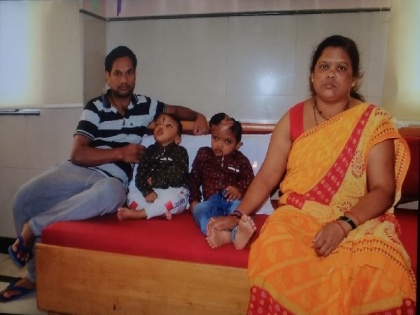Post uncoupling and two year AIIMS stay, Odisha conjoined twins to return home
By ANI | Published: September 1, 2019 09:30 PM2019-09-01T21:30:14+5:302019-09-01T21:45:02+5:30
Almost two years after their conjoined heads were separated in what is touted as India's first successful separation surgery, the All India Institute of Medical Sciences (AIIMS) will discharge twins Jagga and Balia on September 6.

Post uncoupling and two year AIIMS stay, Odisha conjoined twins to return home
New Delhi [India], Sept 1 : Almost two years after their conjoined heads were separated in what is touted as India's first successful separation surgery, the All India Institute of Medical Sciences (AIIMS) will discharge twins Jagga and Balia on September 6.
The toddlers will be travelling via train to their hometown in Odisha and will be getting medical care at Cuttack Medical College, a team of senior AIIMS doctors have decided.
"Jagga and Balia are fit to return back to their place. Now, they are on rehabilitation and physiotherapy which will be monitored by doctors at Cuttack Medical College. AIIMS administration has scheduled September 6 to discharge them," a senior doctor told on condition of anonymity.
The twins, Jagga (Jagganath) and Balia (Balram) were born with fused brain and skull, a condition known as cropagus. They were admitted to AIIMS on July 14, 2017, and their heads were separated after a series of discussion and extensive surgical procedures.
"The MRI of the twins showed fused brains along with a lot of other abnormalities. A team of over 30 senior faculties of various specialities was formed following multiple meetings. Opinions were taken from experts across the globe as separation of blood circulation was very risky," the doctor said.
Dr Deepak Gupta, professor of neurosurgery, who conducted the marathon separation surgery along with a multidisciplinary team of senior doctors told : "It was not an easy task. Those were restless days and sleepless night, because, it was a surgical separation of two brains. These twins shared not only brains with each other but they also were sharing their blood circulation with each other. For any pediatric neuro-surgeon, it is a once in a lifetime surgery. We often address them as AIIMS TWINS," now, he said.
"For the first time, a 3D brain model was developed which was a true replica of brains of AIIMS TWINS to demonstrate the surgical cleavage planes of the brain needed in this surgery. We have designed customized helmets for them, which kids have to wear, he said adding that there is no life-threatening condition for them now."
Jagga and Balia, now four years old, took birth through a normal delivery from a mother in Kandhamal district of Odisha.
The surgery to separate their heads was performed in two major stages. The first surgery was performed on August 28, 2017, which lasted for 25 hours.
The second stage of surgical separation was done a month after the first stage -- on October 25, 2017. Doctors said about 5 skin grafting procedures were done on both the toddlers after the second surgery.
Doctors said cropagus is a very rare situation. Only 2.5 per cent of co-joint twins is cropagus across the world, out of which only 50 per cent of them take birth. Twenty-five per cent of such children who take birth die within 24 hours.
"Jagga and Balia are leading a healthy life like other toddlers of their age. Both can now sit individually and take oral feeding. However, Balia still has a tube inserted in the stomach for diet requirements," said a doctor.
The super active Jagga is now learning to write and read books, scribble on colouring books, playing games, doing physical activities, taking a sunbath and watch the cartoon.
"Jagga enjoys putting oil on the head of his brother Balia after the shower," a doctor, who closely monitored their health status, said.
( With inputs from ANI )
Open in app